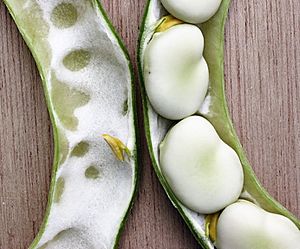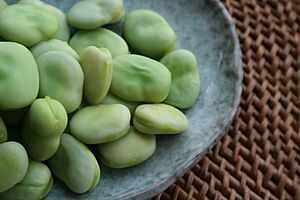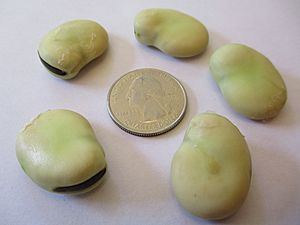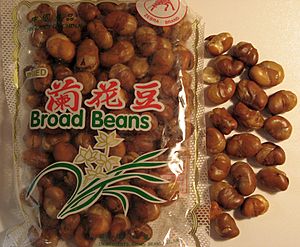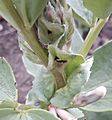Broad bean facts for kids
Quick facts for kids Broad bean |
|
|---|---|
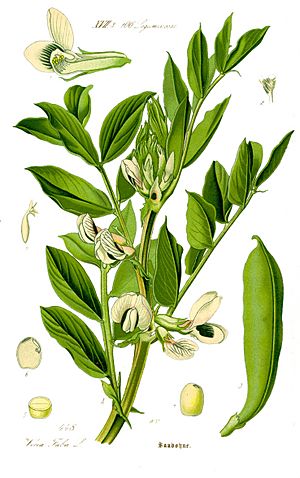 |
|
| Illustration of Vicia faba in flower | |
| Scientific classification | |
| Genus: |
Vicia
|
| Species: |
faba
|
| Synonyms | |
|
Faba sativa Moench. |
|
The broad bean, also called the fava bean or faba bean, is a type of flowering plant. Its scientific name is Vicia faba. It belongs to the pea and bean family, called Fabaceae. People grow broad beans all over the world. They are used as food for humans and animals. Sometimes, they are also planted to help the soil.
Some people have a condition called favism. This means they get sick if they eat broad beans. It's linked to a problem with their body's metabolism. But for most people, broad beans are safe to eat. You can eat them raw or cooked, usually after taking off the outer skin. When the plants are very young, you can even eat the whole pod!
Contents
What Broad Beans Look Like
The broad bean plant stands up straight and grows between 0.5 to 1.8 meters (about 1.5 to 6 feet) tall. It has two to four stems that are square-shaped. Its leaves are 10 to 25 centimeters (4 to 10 inches) long. They have 2 to 7 smaller leaflets and are a cool grey-green color. Unlike many other plants in its family, broad beans don't have special parts called tendrils to help them climb.
The flowers are 1 to 2.5 centimeters (0.4 to 1 inch) long and have five petals. The main petals are white, and the side petals are white with a black spot. There are also rare types with crimson (dark red) flowers. Broad bean flowers have a strong, sweet smell that attracts bees and other helpful pollinators.
The fruit of the plant is a wide, tough pod. It starts green but turns dark brownish-black when it's ready. Wild broad bean pods are 5 to 10 centimeters (2 to 4 inches) long. But the types grown for food can be much bigger, up to 15 to 25 centimeters (6 to 10 inches) long. Each pod holds 3 to 8 seeds. In wild plants, the seeds are small and round. But in food types, they are usually flatter and larger.
How Broad Beans Are Grown
Broad beans have been grown for a very long time, especially in the Old World (Europe, Asia, Africa). They are one of the oldest and easiest plants to grow. People believe they became a part of the eastern Mediterranean diet around 6000 BCE or even earlier. We don't know where their wild ancestor came from.
Broad beans are often planted as a "cover crop." This means they help protect the soil from washing away, especially in winter. Also, because they are a legume, they help add nitrogen to the soil, which makes it healthier for other plants. Many broad bean remains from ancient times have been found in places around the Mediterranean Sea and Central Asia.
This plant is very tough and can grow in cold weather. Unlike most beans, broad beans can grow in salty soils and even in clay soil. However, they grow best in rich, fertile soil.
In many English-speaking countries, "broad bean" is used for the large beans people eat. Smaller, harder seeds are called "horse bean" or "field bean" and are usually for animal feed. However, some people prefer their stronger taste for dishes like falafel. The name "fava bean" comes from the Italian word fava for the bean.
Plant Problems and Diseases
Broad bean plants can get sick, especially in humid (damp) weather. Farmers try to grow types of broad beans that can resist diseases better. Planting rows of beans from west to east can help them dry out more in the sun.
Plant Parasites
In some parts of Europe and North Africa, a plant called Orobanche crenata (carnation-scented broomrape) can attach to broad bean plants. It can cause a lot of damage and reduce how many beans grow.
Fungal Diseases
Chocolate Spot Fungus
A common disease is called "chocolate spot fungus" (Botrytis fabae). It can really hurt how many beans a plant produces. This fungus causes small red-brown spots on the leaves, stems, and pods. It gets worse when it's warm and humid, especially if the soil doesn't have enough potassium or phosphorus.
To prevent it, farmers can plant early to avoid hot, humid weather later in spring. They can also plant fewer seeds or thin out the plants. Special sprays can also help.
Other Fungi
Other fungi like Erysiphe cichoracearum (which causes powdery mildew) and Fusarium solani (which affects roots) can also harm broad beans. Farmers can use resistant types of plants, make sure the soil drains well, and use certain treatments to fight these diseases.
Bacterial Diseases
Xanthomonas and Pseudomonas
Bacteria like Xanthomonas campestris and Pseudomonas syringae can also cause problems. They can spread through infected seeds or stay in old plant parts in the soil. They cause spots on leaves and can make the plant look burned. Using clean seeds and rotating crops (planting different crops each year) can help prevent these issues.
Insect Pests
Black Bean Aphids

Broad bean plants can get covered in tiny insects called black bean aphids, especially in early summer. These aphids often start at the top of the plant. A lot of aphids can reduce how many beans grow and make the pods look bad.
If there are only a few aphids, the plant can usually handle it. But if there are many, farmers might need to use sprays to protect the plants.
Nutrition
Raw broad beans are mostly carbohydrates (58%), with a good amount of protein (26%) and some fat (2%). A 100-gram serving gives you 341 calories. They are packed with important nutrients. They have a lot of Folate and minerals like manganese, phosphorus, magnesium, and iron. They also have many B vitamins.
Health Information
Natural Toxins
Beans generally contain a natural substance called phytohaemagglutinin. The amount in broad beans is quite low, and you can mostly get rid of it by boiling the beans for about 10 minutes.
Broad beans also contain a substance called levodopa. People who take certain medicines for other health conditions should avoid broad beans to prevent problems.
Favism and Genetics
People with favism must avoid broad beans. This is because broad beans contain a substance called vicine, which can cause a serious reaction in them. However, scientists have found types of broad beans that have very low levels of vicine. These low-vicine beans are safe for people with favism to eat.
How People Eat Broad Beans
Broad beans are usually eaten when they are young and soft. You can pick them from mid-spring to late summer. Older, tougher beans (horse beans) are harvested in late autumn and eaten as a pulse (dried bean). You can also cook and eat the young pods and even the young leaves, like spinach.
To prepare broad beans, you first take them out of their pods. Then, you can steam or boil them. Sometimes, people boil them briefly to loosen the outer skin, which they then remove. You can also fry the beans until the skin splits, then add salt or spices for a crunchy snack.
Around the World
Broad beans are eaten in many ways across different cultures:
- In Algeria, they are used to make dishes like Besarah and Doubara.
- In China, especially in Sichuan cuisine, broad beans are mixed with soybeans and chili to make a spicy fermented paste called doubanjiang.
- In Colombia and Ecuador, steamed fava beans with cheese are popular, especially in the Andes mountains.
- In Egypt, fava beans (called fūl) are a very common food. They are the main ingredient in falafel. A popular dish is ful medames, where mashed, cooked beans are mixed with oil, salt, and cumin, often eaten for breakfast with bread. It's considered the Egyptian national dish.
- In Ethiopia, broad beans (baqella) are very popular. They are used to make a flour called shiro for stews. People also eat boiled broad beans as a snack.
- In Greece, broad beans (koukiá) are eaten in a stew with artichokes or boiled with garlic sauce.
- In India, especially in Manipur, they are called hawai-amubi and used in dishes like eromba.
- In Iran, broad beans (Baghalee) are grown a lot. They are cooked in brine with vinegar and spices. A famous dish is baghalee polo, which is rice cooked with broad beans.
- In Iraq, broad beans (Bagilla) are used in many dishes. Bagilla Bil-Dihin is a common breakfast dish with bread soaked in bean water, topped with beans and ghee. Timmen Bagilla is rice cooked with broad beans and dill.
- In Italy, broad beans are popular, especially raw with Pecorino romano cheese. This is a traditional dish for picnics on May 1st. In Sicily, Maccu is a soup made with fava beans.
- In Japan, broad beans (Soramame) are boiled or roasted as a snack called ikarimame.
- In Luxembourg, Judd mat Gaardebounen (smoked pork with broad beans) is the national dish.
- In Malta, broad beans are a main ingredient in kusksu, a vegetable soup. They are also used to make bigilla, a dip similar to hummus.
- In Mexico, fava beans are often eaten in a soup called sopa de habas or as a fried, salted, dried snack.
- In Morocco, they are made into bessara, a popular street food dip.
- In Nepal, fava beans (bakulla) are eaten as a green vegetable or dried and mixed with other beans to make qwati soup.
- In the Netherlands, they are traditionally eaten with fresh savory and melted butter, or with crispy fried bacon.
- In Peru, fava beans (haba(s)) are eaten fresh or dried in many ways, including in soups and stews. They are a key part of Pachamanca, a traditional Andean meal.
- In Portugal, favas are widely grown. A popular dish is favada, a stew with onion and pork.
- In Serbia, broad bean aspic (bobove pihtije) is a winter dish.
- In Spain, habas are used in stews like fabada asturiana or added to other dishes like paella.
- In Sudan, fava beans are a main breakfast dish, similar to Egyptian ful medames.
- In Sweden, broad beans (bondbönor) were traditionally eaten dried and fried, often with fried pork.
- In Syria, broad beans are prepared in many ways for different meals, often with olive oil, lemon, and spices.
- In Turkey, broad beans (bakla) are used in a dish where young pods are simmered in olive oil. A popular appetizer is fava, a puree of dried beans.
- In Vietnam, fava beans (đậu móng heo) are stir-fried with rice noodles and other ingredients in a dish called hủ tiếu lòng heo.
Other Interesting Uses
- In ancient Greece and Rome, people used beans for voting. A white bean meant "yes," and a black bean meant "no."
- The ancient Roman family name Fabius comes from this bean.
- Some old beliefs say that planting beans on Good Friday brings good luck.
- In Italy, small cakes shaped like broad beans, called fave dei morti ("beans of the dead"), are eaten on All Souls Day.
- In Portugal and Spain, a Christmas cake called bolo Rei or roscón de reyes has a fava bean inside. The person who finds it is supposed to buy next year's cake!
- A similar tradition is found in France with the galette des rois.
- The saying "not worth a hill of beans" means something is not valuable, showing how common and simple broad beans were.
- In the Netherlands, roasted or fried broad beans are a special treat in the city of Groningen, where they are called molleboon. The word Molleboon even became a nickname for the people of Groningen.
Gallery
-
Aphis fabae (aphids) on broad bean
-
Lasius niger attending an extrafloral nectary
See also
 In Spanish: Haba para niños
In Spanish: Haba para niños



